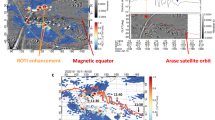Play all audios:

ABSTRACT In May 1983, ionospheric heating experiments were conducted using the Jicamarca very high frequency (VHF) radar facility located ∼11 km east of Lima, Peru. Experiments involving
high frequency (HF) heating of the lower _D_-region of the ionosphere were successfully conducted during 1982 using the Arecibo, Puerto Rico HF transmitter located 5km east at Islote, Puerto
Rico. These local experiments had characterized the signal radiated from a heated and modulated ionospheric current system near the mid-latitudes. A long-path signal had also been received
in September 1982 at Salinas, Puerto Rico from a mid-day equatorial electrojet, heated and modulated by the Jicamarca facility. We have investigated the characteristics of the local signal
that would be radiated from a strong equatorial electrojet when heated and modulated, and report here that at the geomagnetic equator they were similar to, but less intense than, those
observed at Arecibo, Puerto Rico due to parameter differences. This radiation is believed to be the first detected from a heated and modulated equatorial electrojet current system in the
Western Hemisphere. Access through your institution Buy or subscribe This is a preview of subscription content, access via your institution ACCESS OPTIONS Access through your institution
Subscribe to this journal Receive 51 print issues and online access $199.00 per year only $3.90 per issue Learn more Buy this article * Purchase on SpringerLink * Instant access to full
article PDF Buy now Prices may be subject to local taxes which are calculated during checkout ADDITIONAL ACCESS OPTIONS: * Log in * Learn about institutional subscriptions * Read our FAQs *
Contact customer support SIMILAR CONTENT BEING VIEWED BY OTHERS GENERATION OF EQUATORIAL PLASMA BUBBLE AFTER THE 2022 TONGA VOLCANIC ERUPTION Article Open access 22 May 2023 PENETRATION OF
MEV ELECTRONS INTO THE MESOSPHERE ACCOMPANYING PULSATING AURORAE Article Open access 13 July 2021 ENHANCED RESPONSE OF THERMOSPHERIC COOLING EMISSION TO NEGATIVE PRESSURE PULSE Article Open
access 26 April 2024 REFERENCES * Stubbe, P., Kopka, H., Tructveld, M. & Dowden, R. L. _J. atmos. terr. Phys._ 44, 1123–1135 (1982). Article ADS Google Scholar * Ferraro, A. J. _et
al._ _J. atmos. terr. Phys._ 44, 1113–1122 (1982). Article ADS Google Scholar * Jean, A. G., Taggart, H. E. & Wait, J. R. _J. res._ 65, 189–193 (1961). Google Scholar Download
references AUTHOR INFORMATION AUTHORS AND AFFILIATIONS * The Communications and Space Sciences Laboratory, Department of Electrical Engineering, Pennsylvania State University, University
Park, Pennsylvania, USA R. J. Lunnen, H. S. Lee & A. J. Ferraro * Electronic Design Services, Department of Electrical Engineering, Pennsylvania State University, University Park,
Pennsylvania, USA T. W. Collins * Geophysical Institute of Peru, Apartado 3747, Lima, Peru R. F. Woodman Authors * R. J. Lunnen View author publications You can also search for this author
inPubMed Google Scholar * H. S. Lee View author publications You can also search for this author inPubMed Google Scholar * A. J. Ferraro View author publications You can also search for this
author inPubMed Google Scholar * T. W. Collins View author publications You can also search for this author inPubMed Google Scholar * R. F. Woodman View author publications You can also
search for this author inPubMed Google Scholar RIGHTS AND PERMISSIONS Reprints and permissions ABOUT THIS ARTICLE CITE THIS ARTICLE Lunnen, R., Lee, H., Ferraro, A. _et al._ Detection of
radiation from a heated and modulated equatorial electrojet current system. _Nature_ 311, 134–135 (1984). https://doi.org/10.1038/311134a0 Download citation * Received: 01 May 1984 *
Accepted: 04 July 1984 * Issue Date: 13 September 1984 * DOI: https://doi.org/10.1038/311134a0 SHARE THIS ARTICLE Anyone you share the following link with will be able to read this content:
Get shareable link Sorry, a shareable link is not currently available for this article. Copy to clipboard Provided by the Springer Nature SharedIt content-sharing initiative
